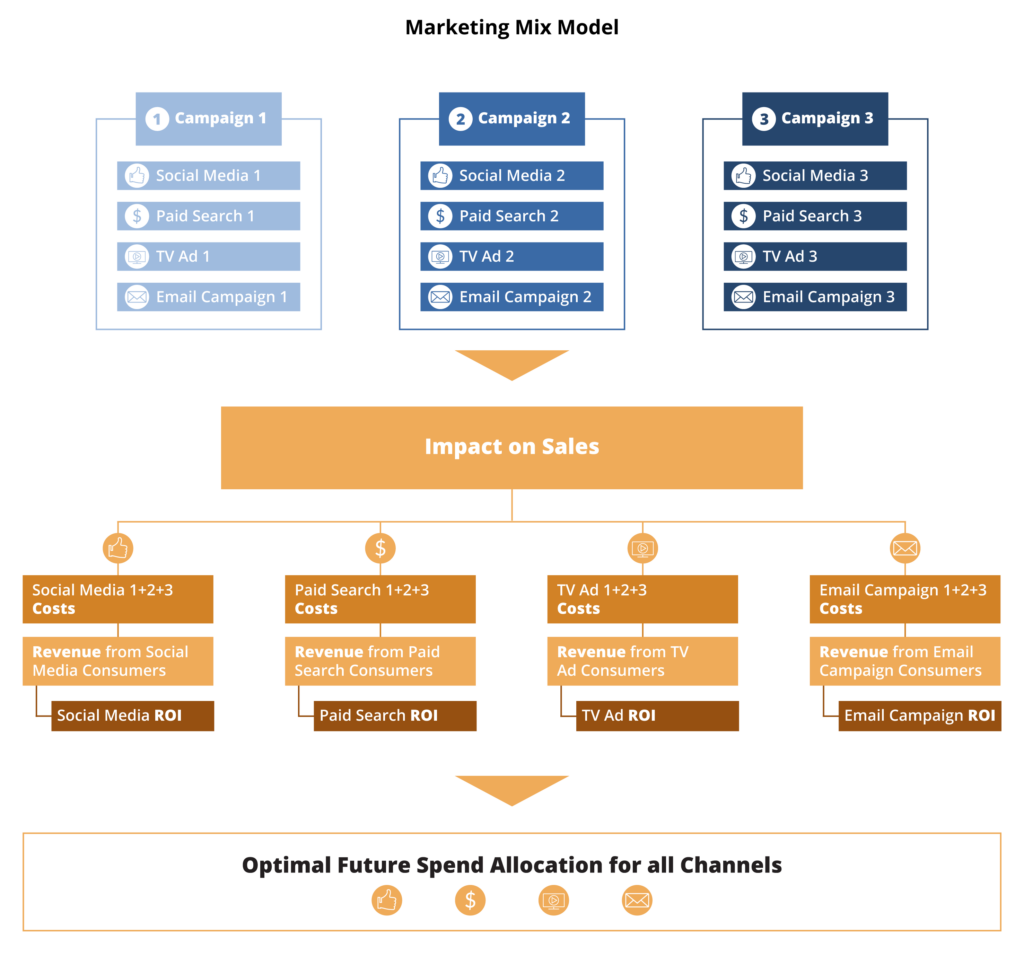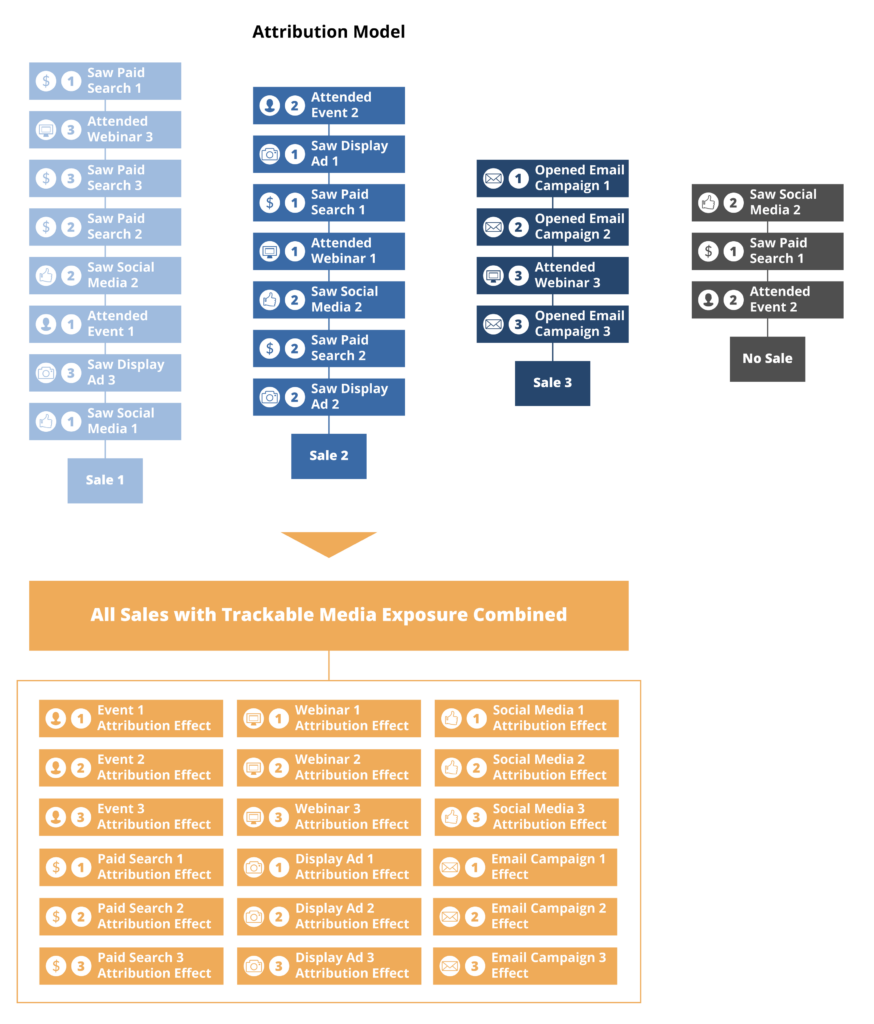While marketing in general is capable of bringing additional sales, effectiveness of any particular campaign, channel, touch point etc. may vary substantially. To evaluate performance, historically there have been two approaches – Marketing Mix Modeling (MMM) and Attribution modeling. Here we examine differences, advantages and disadvantages of both approaches.
Marketing Mix Modeling: Cost and Sales Related to Media Initiatives
Marketing Mix Models are typically used to allocate budgets across paid media. This type of model estimates the impact of various media initiatives on sales at the aggregate level by time, line of business and geography – for example weekly sales in a specific market area for a particular brand. Each media initiative, such as spending on a particular channel or campaign for any particular type of media would be a separate independent variable, transformed to account for saturation and time decay. Here saturation is the diminishing effectiveness of an initiative – i.e. any particular market has limited size, and as media presence is increased, it would inevitably touch consumers that are already exposed to the brand and would not buy any more of it. Time decay accounts for the possibility of consumers acting on media exposure with delay. But, the longer the delay, the less a chance of media influencing purchase – hence the decay.

Typically, such models are estimated via regression, with sales being the dependent variable, and media-specific metrics for each initiative (spot, channel, campaign, etc. all being possible levels of analysis) as independent variables, with other independent variables present to account for non-media factors (such as price or seasonality). One of the substantial features of MMM is decomposition of sales volume into base and incremental sales. Base is sales due to non-media variables, and incremental sales are due to each media initiative. With known media cost and the measure of incremental sales attributed to the marketing efforts, calculating ROI for each initiative is straightforward. Moreover, simulation and optimization tools can be built upon the model providing projections for better media spend allocation in the future.
The main advantage of MMM compared to Attribution models is that MMM accounts for the effects of all paid media including mass media, and takes into consideration the effects of saturation and decay as well as the base sales that would have occurred without the media spend. The disadvantage of MMM compared to Attribution is that, because it includes spending and effects of non-trackable media, it is calculated only at the aggregate level whereas Attribution allows for a higher degree of drill-down detail which we cover next.
Attribution Modeling: Measuring Sources of Exposure Driving Conversion
Attribution modeling estimates the impact of different touchpoints on a conversion, and is used to optimize tactics across trackable marketing. Such a model is an individual level model, with a binary dependent variable – either there was a conversion, or not. Each media variable represents a particular touchpoint. Other variables, such as geography and price can be included to account for non-marketing effects. A conversion can also be decomposed into a base and incremental portion, later indicating increased likelihood of a conversion due to any particular touchpoint. Typically, such models are estimated via a machine learning binary classifier, such as logistic regression. ROI calculations are possible by adding across individual conversions a percentage of conversions attributed to each marketing effort.

Because Attribution modeling considers media exposure and sales conversion at the individual level, it measures the relative impact of the various trackable media exposures and in turn can be used to determine which channels are most effective for the different types of audiences, which is not possible with MMM. Attribution models can also measure the impacts of referral channels other than known social media platforms or organic search engines which can lead to optimization actions such as establishing new partnerships, or can be used to measure incremental changes to conversion due to implementation of tactical or platform changes, among other uses.
Unlike with MMM, media channels that cannot be attributed to an individual consumer cannot be included in the Attribution model (i.e. TV and billboard). In such cases full decomposition of sales into base and incremental is not possible, and the incremental figures for the media in the model would be biased, as it assumes constant effect of non-observed media channels for each consumer.
When to Use MMM versus Attribution
To sum up, a Marketing Mix Model is an aggregate level model that takes into account all media initiatives. It produces ROI metrics and measures effectiveness of each media initiative, allowing for spend optimization across media and time periods in the future. Attribution is an individual level model that takes into account only the marketing exposure that can be traced to an individual customer. It estimates touchpoint effectiveness and allows for optimizing spend at individual touchpoints in consideration of the audience or product being promoted.
Marketing is important for any organization but without analysis and optimization of those practices, how do you know you’re getting the most out of your marketing budget? Whether you’ve never evaluated your marketing efforts before or you’re a seasoned team looking to increase manpower quickly, Fulcrum has you covered. Contact us today to find out how we can help enhance your marketing efforts for quick wins while optimizing your marketing practices for long term success.



